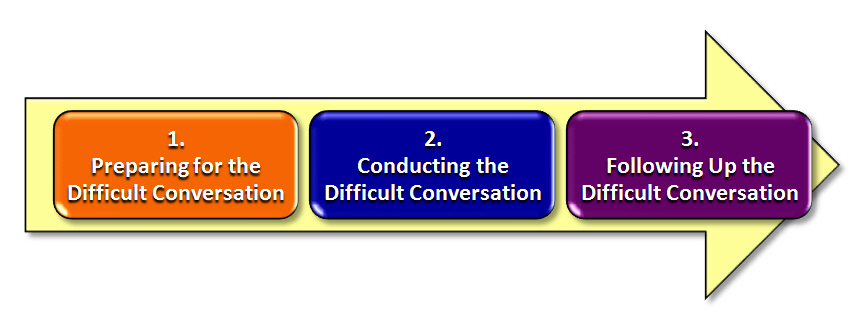How Effective Leaders Master Necessary but Difficult Conversations, Part 2
Posted in Career Search Tools & Education, Dynamic Training News, Improve Sales & Profits, Latest Leadership Posts, Leadership Development & Training, Talent Development & Training on Sep 30,2025
In Part 1 of this article we explored what makes a difficult conversation difficult. In this second article we’ll consider a few practical steps to take to make a difficult conversation more effective and less stressful.
Planning is Your Number One Strategy
Not all things in life can and should be planned. But if you are the one initiating the difficult conversation, it is essential that you thoroughly plan for the conversation. And plan for the things that will likely not go according to your preferred plan.
Planning should take place at EACH of the stages below in order to assure that each stage goes as smoothly as possible. For example, you cannot address follow-up in a discussion (and have a plan to offer) unless you’ve committed time to planning it. Your highest risk stage is stage 2, since emotions can flare despite your best planning, especially if you rise to the same emotional level as the person you’re talking to. Keeping the conversation on track (as per your plan) is also a challenge, especially if the other person tends to seize control of the conversation or send it in a different direction.

Understanding Your Objective
The primary objective should be to have a positive learning experience for both of you, a sense of shared objectives in growing past the issue prompting the discussion and strengthening the relationship between both of you. It should instill a sense of team and belonging. Both of you have to desire to cooperate and move past the issue(s). In order for this to happen, both must be open to the discussion and willing to be humble. There is no winner or loser in the conversation – both should emerge winners and both being more effective as a result. This speaks to the INTENT both of you have in participating in discussions that aren’t easy but will ultimately lead to positives.
Preparing for a Difficult Conversation
Preparing to be an excellent listener. According to Joel Garfinkle in his book Difficult Conversations, the Number One secret for starting a difficult conversation is not what you say, but how you listen. Listening is an intentional act of the listener’s will, a TOTAL focus on the other person in order to not only understand the words, but also the message communicated in his/her body language, emotions, and delivery.
- To most people in most cultures, listening equals respect.
- Effective listening means asking clarifying questions.
- Effective listening requires your own body language to be open.
- It requires the listener to intentionally suspend his/her judgment of what is being said until after all is said. This is often the most challenging action to execute well.
- Live out the advice of Stephen Covey: “Seek first to understand, then to be understood.”
- Taking notes aids your listening.
Preparing the discussion location. The location should be private, distraction and interruption-free. Seating should be collaborative, such as at a small round table, or around the corner of a table, on a couch, or side chairs at a 90-degree angle. Avoid placing barriers between you, and your seat higher than theirs.
Preparing your emotions and attitudes. Preparation in this area means that you are much less likely to be reactive (and the emotions that can go along with reacting). Because you’ve thought through what could happen, you’ve anticipated the possible negative responses you might encounter and how you want to respond. You may even need to graciously admit you are the one most at fault!
Preparing your discussion points. Think through these discussion points (write them as bullet points):
- The outcomes you want the conversation to produce.
- The facts and data to support what is being discussed.
- Open-ended questions that will prompt a positive dialog and allow both of you to cooperatively explore what happened.
- Points that you want to make as the opportunity presents itself.
- Identify the things you might have done that could contribute to the problem.
Practice. Using your discussion points, practice being able to deliver your message with an appropriate tone of voice and body language. Consider practicing in front of a mirror so you can see yourself. Once you’ve practiced by yourself, ask a partner to play the person with whom you plan to initiate the difficult conversation. Ask your partner to push back so you can practice keeping your emotions in control and your body language open.
Holding the Difficult Conversation
Just before you start. Center yourself by visualizing the process with you successfully conducting the session with a positive outcome.
Open and conduct the discussion. Start off by succinctly stating why the meeting is taking place. You may want to set the tone for the discussion by stating you may be to blame in part for the situation and your intention to have an open discussion about it. Then begin by asking open-ended questions and listening.
“Sue, I wanted to meet with you to discuss what happened yesterday between you and Ed. I’ve had several people in the department express their discomfort with the tension that now exists. I may be partly to blame for the situation, so I’d like us to have an open discussion to learn more. Can you please tell me in your own words what happened?”
Then execute your discussion plan as you had envisioned and practiced it. Keep your emotions in check…by you being calm but concerned, you’ll set the tone for the discussion. If you get sidetracked on a point, that’s okay, but move gently back to your plan when you can. You may need to restate the objective to help the other person keep the conversation moving forward. Keep asking open-ended questions to explore what is not clear, eventually moving into a problem-solving mode with him or her to address the situation.
Build your next-steps plan and help him/her manage it. As you both solve problems together, suggest building an action plan that moves you both forward. Both of you should be taking notes. It is his or her plan, not yours – you play the role of thinking partner, there to support his or her plan. As you move toward the close of the session, summarize the plan and detail what is to be done, by whom and by when. Set the date for your follow-up meetings. Thank him or her for remaining open and willing to work through the issues, and your belief in him or her as a valued member of the team.
Keep a close observation of his or her performance or behavior and provide reinforcing or corrective feedback as appropriate. Look for positive progress. Keep your scheduled follow-up meetings and help him or her stay on track. Keep a record of his or her progress. And celebrate the victories!
Bottom Line
A mark of an effective leader is how he or she manages difficult conversations that arise during the course of work. When leaders are adept at creating a calm, collegial conversation, emotions are defused, and relationships are built.
This article was in part excerpted from module 27 of the acclaimed leadership training program, Leading Through People™, which has made a positive difference for more than 20,000 supervisors, managers, and leaders worldwide.
About me: Since founding Boyer Management Group 26 years ago, I’ve been blessed to work with some of the world’s top employers by helping them get the most out of their talented people. Thanks to our clients, the company I founded in 1998, Boyer Management Group, was recognized by CEO Monthly Magazine in 2023 and again in 2024, awarding us their “Most Influential CEO Award” in the executive coaching field. Our coaching programs produce remarkable results in compressed periods of time. Our extensive leadership development course catalog provides effective skills-building for everyone in the organization, from the new and developing leader to the seasoned C-level executive. BMG boasts one of the most extensive sales and sales management curriculums anywhere, with behavioral assessments to help develop talent. To find out more, please visit us at www.boyermanagement.com, email us at info@boyermanagement.com, or call us at 215-942-0982.
Latest Leadership Posts
Why do You Permit C-Players to Destroy Your Team? Continue Reading
Are You Living ABOVE or BELOW Your Means? Continue Reading
Does Your Self-Improvement Strategy Include This Difference-Maker? Continue Reading



